Passion for Color? – Try This Method!
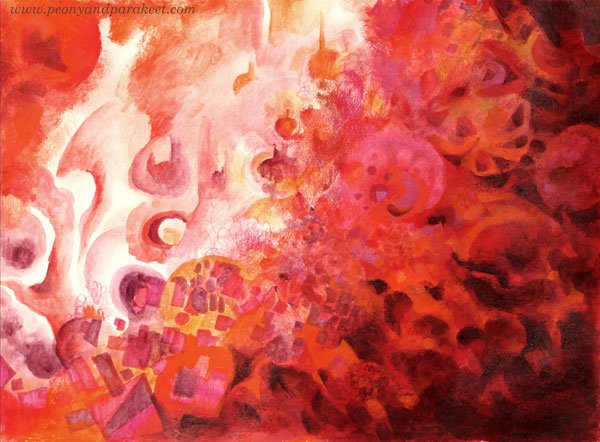
Create a color-focused art journal page! You can choose as many supplies as you want but just one color!
Step 1 – Pick Your Color!
What color speaks to you today? Red, blue, yellow, green, brown, black … Pick any that you feel drawn to! Collect the art supplies that you have in that color!
In most mornings, after taking the dogs out, I go to my studio and start creating sketches, or art journal pages, or continue paintings in progress. I often make a hot beverage called Sunny Grapefruit. I have bought it from a tea shop, but it doesn’t contain any tea, just fruits, and lemongrass. I sit down in an Ikea chair found at a flea market. I have painted it and put a sheep fleece on it, so it’s warm and cozy. All this warmth made me think about red.

I chose the supplies so that they were all various tones of red ranging from orange to pink.
Step 2 – Source of Energy
Your color is the source of energy. Pick any coloring supply and make a simple circle somewhere on the page! However, don’t begin in the middle! Your work will look more expressive if you don’t make it symmetric.

I colored a soft circle with a couple of Faber-Castell Gelato Sticks.
Step 3 – Radiating Power
Add more color to the circle with different supplies! Imagine that your passion radiates strength. Use your imagination to color shapes and lines that are connected to the circle. Again, keep the design asymmetric.

I used colored pencils and thought about the sun and the fire. You can use your imagination based on the ideas that the color evokes. For example, if your color is blue, you can think about waves and the energy and the movement that they contain. Don’t overthink; it’s just a start! Usually, we get conventional ideas in the beginning but then become more inventive as the work progresses.
Step 4 – Explosion and Spin-Off
Change the supplies again, and imagine an explosion of energy. Let your circle grow but also become less solid. Create a spin-off that has a life of its own.

I used Derwent Artbars and water. I could have used watercolors instead, but nowadays, I often find it quicker to grab some Artbars and use a water brush when I am creating a mixed media piece.

Step 5 – Look Around!
So far you have focused on one area of the page. Now imagine, that the explosion reveals some of the surroundings. Add some pale elements but don’t cover the whole page.
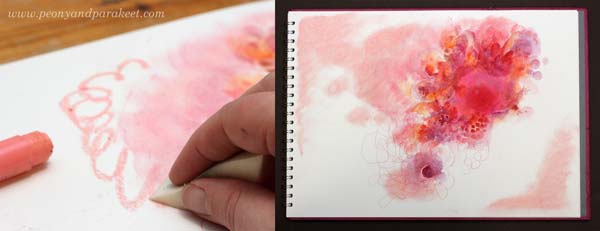
I just made some soft splotches with Faber-Castell Gelatos. Notice how my explosion travels diagonally across the page and reveals areas that are also diagonal but in the reverse direction. Diagonals make the image look dynamic.
Step 6 – Birth
Color clearly-defined shapes that connect the energy source and the spin-off. Imagine that something concrete is born out of the explosion and moves forward.

I colored geometric shapes with Fabel Castell PITT Artist Pens. To highlight the movement, I make the shapes cross over each other. I also add bigger shapes that are shown only partly so that it looks like they are flying away.
Step 7 – Mountains
Color a big area of the page so that it’s like mountains have grown to your page. Again, keep one part of the page blank. Add some color to the other side of the blank area too so that the blank area is like a gulley between the mountains.
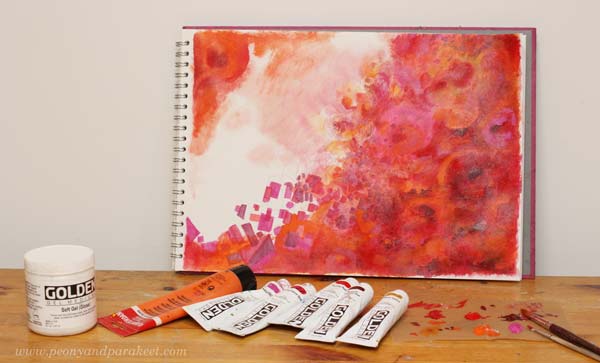
If you have acrylic paints, now it’s a good time to use those. Painting is quicker than coloring with pens, and you can also create layers easily.

I use gel medium to make the acrylic paint more fluid and translucent. I also use two brushes so that there’s more variation in the brush strokes.
Step 8 – Jump!
Imagine being up in the mountains, looking down to the gulley. When you jump, you begin to see that the blank area also contains wonders. The fall is not so high than what you first expected. Softly color some vague shapes in the blank area.
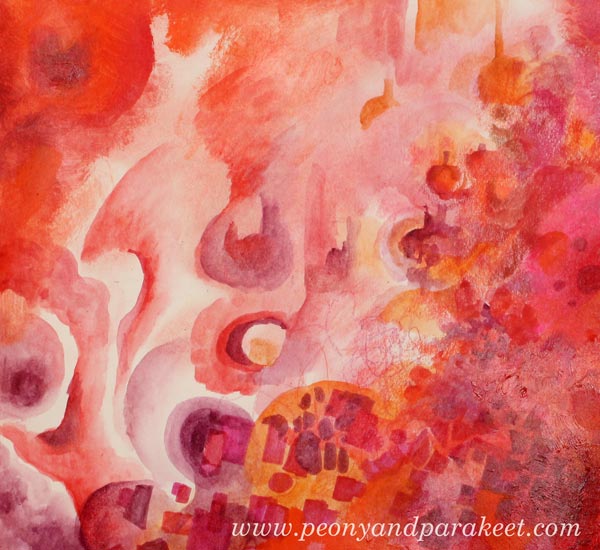
I used Derwent Artbars and water.
Step 9 – Test and Adjust!
When creating abstract art, I find it practical to test it based on how well it fits with other patterns, textures, and shapes. I placed my sketchbook near the fireplace where we have a place to watch the fire. To me, it looks like my page doesn’t have enough contrast.
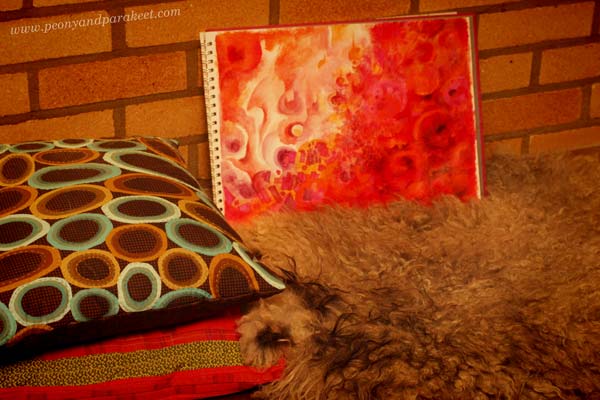
So I add some alizarin red which is very dark and some lighter orange to finish the mountain area.

Now the contrast looks better.

Learning to Create – Using a Model, “How To,” or a Method?
There are many ways to learn:
a) Watching someone create and then following it accurately. This way you will create something that you wouldn’t have thought of figuring out yourself. The downside is that your expression and imagination has very little space to come through. You are learning technical skills mostly. Sometimes it can happen that you don’t know why you do what you do.
b) Learning how to use certain supplies in a certain manner. This makes you learn the characteristics of a certain art supply and the techniques that you can use. You can then use the techniques to produce your unique art. The downside is that if you don’t connect with your imagination, you lose the joy of creating. You know why you do what you do but don’t know where else you could use it.
c) Following a method that connects you with your imagination. This gives you preliminary ideas that you can then expand to fit your thoughts and to grow your style. The downside is that if you have no idea how to use the supplies, it will take up your energy.
My Methods

As a teacher and a mentor, I focus on the methods that grow the expression and imagination. Even if I value knowledge and techniques, my strength is in innovating new methods that help you to connect with your creativity. I have heard many say that when they analyze someone’s art, it’s easiest to focus on the technical part. I agree. There are more rights and wrongs to catch. But after creating in a very disciplined manner for the last year, I have come to this conclusion both as an artist and as a mentor: I want to grow my skills to all directions, but if I had to pick one, it would be imagination.
Boost Your Visual Imagination!
Without imagination, we just go around the same circle. We don’t feel free, and we end up believing that there’s one more technical trick around the corner that will change the game. But it’s the imagination that will do that. That’s why I don’t select students based on their supplies, or the technique or style they use. Together, we share our love for making the invisible visible and learning to use the techniques to serve that.
Boost your imagination by joining my community Bloom and Fly! We’ll start with a method for your creative goals, then pick easy ideas from Rococo, explore abstracts together, etc. I will help you to express yourself so that it’s adventurous and imaginative! >> Sign up here!
Mixed Media Sketchbook as a Tool for Self-Discovery
This week, I am talking about using a mixed media sketchbook or an art journal in a new way.
Mixed Media Sketchbook – Watch the video!
Bloom and Fly! – Set Your Goals and Start Creating!
My community Bloom and Fly is for all who want to start and keep on creating. You can get help and encouragement for any art project, and we also have monthly themes.
January’s theme is “Mixed Media Sketchbook as a Tool for Setting Your Goals.” You will get ideas on how to use a sketchbook or an art journal for creative goals. Rather than feeling restricted, you will feel energized by the possibilities behind the goals. An art journal can be a playbook that keeps you moving forward!
Make sure that 2018 is your year of art – Join Bloom and Fly!
How to Make Your Art More Captivating

Captivating is a big word, but I like to explore it from many angles. In this blog post, I give you six tips with examples. The first two are more related to the process of creating art than to the result. I believe that if the process itself doesn’t captivate, it’s less likely that the final piece will! The last four tips are about finishing your art so that it will be compelling.
1) Captivating Supplies – Choose What Gets You Going!
Using too many art supplies can cause overwhelm and unnecessary distraction. I choose the supplies based on how many hours I want to work on the project.
- Under an hour: Black drawing pen and colored pencils. They are quick to grab and work on any paper.
- Few hours: Water-soluble media like watercolors or inks. They cover big areas quickly, but they also allow detailed work, especially when combined with colored pencils.
- Tens of hours: Acrylic or oil paints. The result lasts time and can include tens of layers.
The projects shown in this blog post have taken 2-4 hours. These are all created with water-soluble media but this time, not with watercolors or inks. Namely, while organizing my supplies, I found Faber-Castell Gelatos and Derwent Artbars from my stash. I bought them many years ago when I was obsessed with having all the mixed media artist’s stuff. I purchased this and that, tried everything for few times, and then got disappointed because they didn’t improve my art. My solution back then was to reduce the number of art supplies and learn more about the basics of visual communication. It worked much better than hoping for the miracle with the new supplies!
But now when I opened the boxes, I was looking at Fabel-Castell Gelatos and Derwent Artbars with the new perspective. They could be quick and handy for sketchbooks and art journals. Because both of them are water-soluble, they could watercolors and inks once in a while.

I have now used Derwent Artbars and Faber-Castell Gelatos for my big sketchbook. I use Artbars for detailed brushwork and Gelatos for big and blurry areas.It has been quick and fun. The downside is that the result is quite waxy and I don’t think it will endure time very well. Furthermore, I can’t cover the opposite page because the staining would ruin it. However, the old and neglected supplies have managed to inspire me, and I think it shows in my recent work as well. The image above shows how I started the piece that you can find at the beginning of this blog post.
2) Captivating Looseness – Start without Intention!
The second captivating thing is related to the process of creating as well. I like to start most of my pieces, whether they are small sketches, bigger art journal pages, or big paintings intuitively without accurate planning. Sometimes I have an image, a word or a style in mind. It inspires me to start, but as soon as I have sat down and made the first strokes, I try to let go of it and just enjoy creating freely from the imagination. In this short video, you see me working with Derwent Artbars and Faber-Castell Gelatos.
More videos: I have explained my adventurous creative process shortly in a mini-course called Loosed Up! It’s free for the subscribers of my weekly emails. If you haven’t a subscriber yet, subscribe here!
3) Captivating Story – Make Fantasy Portraits!
Artists often talk about communicating a story through art. Usually, referring to the story doesn’t mean so much what’s in the image, but how the image can deliver a handle to the viewer’s personal stories. One of the easiest ways to embark stories is to make a portrait that is relatable.
Even if you have started freely and intuitively, you can turn almost any blotch to a face, especially a side profile, by adding a color area that defines it. In my piece, I realized that with black, I could bring up two persons. I was intrigued by showing the connection between the two fantasy figures. To me, they express the two sides of me, when I am creating. One side is more feminine, full of emotion and ideas, and the other more masculine, trying to figure out how to put the ideas into subsequent steps. At best, these two sides work together and enter the same flow.

In the enlargement, you can see that the dark areas also include subtle details so that they are not monotone and so that they communicate the connection. The colors also play a role here. Blue expresses the connection that the two share together.

The story that you see in this piece doesn’t have to be the same than what I have told. For you, the image can bring a romantic moment to mind. Or it can take you to a fantasy movie. In the same way, the art that you make can have several meanings and when creating, focusing on the general message makes it more captivating. In this case, the message is the shared connection, and I have tried to adjust the details so that they all support this message.
4) Captivating Richness – Build a System!
Usually, the longer we work with one piece, the more valuable it will become. Not only that we get more attached to it ourselves, or that it has a higher monetary value, but also that time brings the richness of the details. This is especially the case if you don’t try to get the piece finished in one sitting but let it captivate your mind between the sessions.

Many artists are afraid of “overworking,” but to my experience, “underworking” is more common. Also, only creating tiny pieces can be one form of underworking. See how a small art journal page, a modest scene, grew to a captivating system or a map when I continued the page!

When working with a detailed big picture, remember to leave some breathing space between crowded areas. Connected lines between the clusters make sure that your system is like a running machine with all the necessary pieces.

5) Captivating Clarity – Highlight a Direction!
Sometimes clarity can be more captivating than an overwhelming amount of details. My example is an orange that I drew one morning after a fruity breakfast.
I apologize for the low quality of the first image below. There you can see a shadow of me shooting the photo with my mobile phone. But actually, it brings up a good point about the clarity: when you are in doubt what to add, take a photo. It helps you to see your work with different eyes. You can zoom out to test if your image looks both clear and interesting when it’s small. You can also analyze, how your eye wanders around the work and where do you want to lead it. If your art looks like one big mess, adding a direction also brings more clarity.

With the orange, I wanted to express the forward-thinking attitude that I usually have in the early mornings. I wanted to add more importance to the single juicy drop that leaves the orange with the bouncing energy. The idea behind the illustration was not just express a fruit that explodes but how a source of energy can keep you moving forward. It’s similar to the idea of my community Bloom and Fly – to keep you inspired to create and remove creative blocks that prevent you from that!

6) Captivating Contrast – Use Two Different Styles!
The last tip is about contrast. However, this time I don’t bring up the contrast in color, value, or size, but in style! Now you might say: “Paivi, I have been searching for a personal visual voice for so long. Are you talking about mixing different styles to one piece?” I certainly am! Don’t be a one-trick pony but go to see all kinds of art and practice all sorts of styles! Your technical skills will grow, and you will get ground-breaking ideas. Showing the versatility can also make your art more captivating. See how I combined abstract with realism how it makes the images more captivating and thought-provoking.

With a realistic pansy, I was able to communicate the contradiction that we all get when we envy someone: “When a jewel wants to feel free and be a pansy … And when the pansy secretly wishes to live forever and be the jewel.”

By adding the realistic eye, I was able to express the difference between two different worlds – the inner and the outer world. Paul Klee has said it so brilliantly: One eye sees, the other feels.”

Set Your Goals and Start Creating!
My community Bloom and Fly is for all who want to start and keep on creating. You can get help and encouragement for any art project, and we also have monthly themes.
January’s theme is “Mixed Media Sketchbook as a Tool for Setting Your Goals.” You will get ideas on how to use a sketchbook or an art journal for creative goals. Rather than feeling restricted, you will feel energized by the possibilities behind the goals. An art journal can be a playbook that keeps you moving forward!
With January’s theme, you will also get easy jumpstarts for stepping into the world of art journaling without feeling the pressure to buy more supplies. The money spent on staying inspired and connected with like-minded artists can be more useful than adding extra supplies to your stash.
Make sure that 2018 is your year of art – Join Bloom and Fly!
Lazy Art Journaler? – Try This Method!

Do you keep an art journal or a sketchbook? Are you struggling to find your motivation for filling it regularly? Try this method, geared for a lazy art journaler and for those who have big creative blocks!
“How to” for a Lazy Art Journaler
1) Create one small area at a time like you were slowly building a map.
2) Write down your thoughts. They can be roads from one area to another.
3) Accept that you are stiff and conventional when you begin. The beginning is the home base, and it should make you feel safe and grounded.
4) When you leave the home base and move to the next small area, just focus on creating different than what you have so far.
5) Don’t overthink. One area can be only one spot of color that you feel drawn to. Then add a small dot or line of another color to embark your imagination.
6) You can travel far in one sitting, or stay near the home base. One journey to your imagination can last weeks if that’s what it takes to fill the page.
7) If you want the page to be coherent, repeat some of the elements once in a while.
8) Artists are explorers. Never underestimate the meaning of this practice. Be open to what you can discover. When you are far away from your home base, take risks! In the end, it’s just paper and pigment, and any filled journal beats an empty one!

Get More Inspiration for Creating! – Join Bloom and Fly!
Bloom and Fly is a new community for everyone who wants to stay inspired and move forward in art.
We’ll start the new year with the theme “Mixed Media Sketchbooks for Setting Your Goals”. You will discover fun ways to get a grab on what you want to create in 2018!
In February, we’ll dive into the world of Rococo and Marie Antoinette and you’ll get ideas for any style of art. In March, you will get jumpstarts for adding abstract elements to your art. Whether you like realistic or fully abstract art, starting with abstract elements can boost your creative process.
